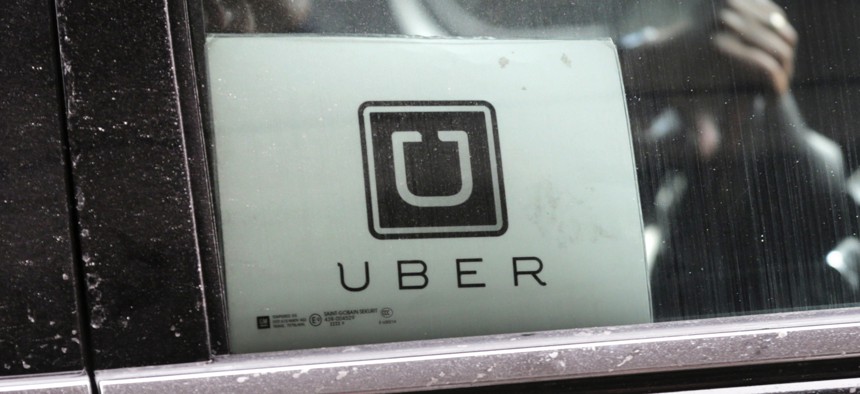The Uber-Transit Convergence Arrives in Denver

Uber is joining forces with public transit for the first time. Seth Wenig/AP Photo
The ride-hailing giant once called public transportation a threat to its growth. But in one city, it’s joining forces.
For a company that has viewed public transit systems as its competitor, it seems like an odd move: Uber wants to make it easier for Denver commuters to ride buses and trains.
Starting Thursday, the ride-hailing giant will offer a portal within its app for travelers buy tickets for rides aboard the Regional Transportation District, the transit system serving the greater Denver area. Trip prices will be the same as they are through any other RTD option. The option to choose “transit” will pop up in the Uber app after riders enter their destination, which leads to a mobile ticketing platform.
The move is part of a progression: In January, Uber launched a trip-planning service within its mobile platform that included RTD options. In other cities, dockless scooters and bikes are also available for rent, in-app.
Uber has joined with public transit agencies throughout the world to fill in gaps where buses and paratransit don’t provide adequate service to riders, or are too costly for agencies to support. (In at least one town, its vehicles have superseded transit service entirely.) But Denver marks its first attempt to integrate mass transportation options directly into its app.
“For the first time ever, taking an Uber trip can mean taking public transit,” David Reich, Uber’s head of transit, said in a press release following Thursday’s launch. “With this step, we are moving closer to making Uber’s platform a one-stop shop for transportation access, from shared rides to buses and bikes.”
The announcement suggests that Uber enjoys a spirit of friendly cooperation with rival modes, an idea that many others dispute.
Ride-hailing companies have long insisted they can be complementary to public transportation, in that they offer convenient connections to transit stations. This theoretically helps commuters avoid driving by themselves. But that claim contrasts with an emerging consensus among urban economists and transportation scholars that ride-hailing is a drain on public transit ridership, which is in sharp decline on systems around the U.S. More than one-third of Americans now report that they have used ride-hailing services.
Particularly in cities where commuters across a range of income levels rely on buses and trains—such as New York City, Boston, and the Bay Area—Uber and Lyft seem to be luring away riders who can afford the private car trips. In Denver, for example, transit usage declined even as population and transit investments grew. Deteriorating infrastructure and unreliability are major “push” factors from transit systems, too.
What’s more, in an early draft of its S-1 filing to the U.S. Securities and Exchange Commission ahead of its IPO, Uber highlighted public transportation as a major challenger to its future growth. It estimated that the global transit market is worth $1 trillion, and that Uber would have to compete better in order to seize that share. Transportation experts were aghast, pointing to the congestion and environmental damage that would be unleashed should buses be supplanted by black cars.
Uber later revised the document, instead characterizing transit as an opportunity. “Partnerships with public transportation and future potential offerings, such as in-app journey planning and fare ticketing, could help us address these 4.4 trillion public transportation miles,” it stated.
Uber lost $2 billion in 2018. Analysts predict that Uber’s and Lyft’s inexpensive fares, long subsidized by billions in private venture capital, will rise once public investors expect returns. The low cost to consumers have also been enabled by legions of contract-based drivers, who often don’t earn much more than minimum wage after expenses.
In previous years, Uber pinned its profitability hopes on replacing those human drivers with autonomous vehicles. But in 2018, a pedestrian in Arizona was struck and killed by an autonomous Uber in testing mode, and the company’s AV program has been less of emphasis under current CEO Dara Khosrowshahi. Most experts believe the age of robotic taxis is a decade or more away, if it ever comes.
Denver may be an ideal proving ground to see if a marriage between ride-hailing and transit can be mutually beneficial, at least. The booming mountain metro has recently made major investments in building out a rail and bus network to better connect its suburbs to downtown. (As CityLab’s Sarah Holder reports, still more transit service is coming.) But so far, the region’s sprawling layout has made it difficult to attract once-projected levels of ridership. Both sides may well have something to gain in a union that takes advantage of Uber-to-station commutes.
“This exciting next phase of RTD’s collaboration with Uber is yet another way our transit agency is leading the dialogue about mobility strategy, not just for the Denver metro region but for cities across the globe,” RTD CEO and general manager Dave Genova said in a statement. “This project broadens our reach and stays at pace with the public’s needs, allowing people to plan and pay for trips from start to finish.”
Laura Bliss is CityLab’s west coast bureau chief, covering transportation and technology.
NEXT STORY: Infrastructure Week Became a Joke. Now It’s for Real.





